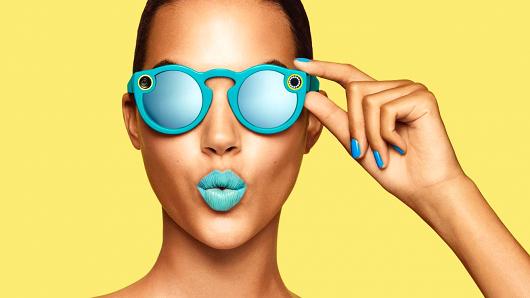If Snap’s lighthearted rebrand takes off, it could pave the way for serious new lines of business — including augmented and virtual reality, experts told CNBC.
Along with a name change, the company behind Snapchat released over the weekend a new set of glasses that lets users capture short videos from their own perspective and post it to the app. The product, $129.99 Spectacles, rolled out with a colorful, retro-lite look and asizzle reel of some roguish young people recording their skateboard tricks.
Snapchat declined to share anything further with CNBC about its plans. Josh Elman, partner at venture capital firm Greylock Partners, said under its fun, unassuming exterior, Spectacles could also be a test for how far Snapchat could expand its brand into new areas.
“I think Snapchat is pushing the edges of what the camera is,” he told CNBC’s “Squawk Alley” on Monday. “I think their brand is so strong with people in their early 20s that they might sell a lot more of these than anybody is predicting. … They’re positioning it as this fun toy for people to engage with, not something that you need to think about as your next big technology investment.”‘
While Elman didn’t mention specific applications, he said that Spectacles extends Snapchat’s ambitions to be users’ default camera.
“I think it’s the beginning of a much broader set of things we’re going to see from Snap, [such as] I think the ability to change how people think of the camera — it’s not just something you hold and shoot, you take out of your pocket or out of a case — it’s right there with you all the time,” Elman said.
For now, it’s all speculative, as Spectacles remain a fashion statement and a way to post to the Snapchat app.
CEO Evan Spiegel called the new product a “toy” to be worn “for kicks at a barbecue and outdoor concert.” “It’s about us figuring out if it fits into people’s lives and seeing how they like it,” Spiegel told The Wall Street Journal.
But virtual or augmented reality could be one path forward for Spectacles.
The product records circular video with a 115-degree field of view and sends snaps to the mobile phone app to be viewed. Because of the circular way video is captured, Spectacles could one day be the preferred way to play back Snaps, paving the way for virtual and augmented reality in the future, according to Sophia Dominguez, CEO and co-founder at SVRF, a search and discovery engine for virtual reality content.
After all, Snapchat reportedly acquired 3-D capture company Seeneearlier this year. Dominguez also points to a since-deleted August tweet, from virtual reality app creator Joshua Farkas.
“We received an offer we can’t refuse to buy @SpectacleVR name. App will be reborn. New name, more features,” Farkas tweeted.
Snapchat has arguably already started driving a quiet revolution in augmented reality, spurring mass adoption with its Lenses, according to a post by Jeremy Liew of Lightspeed Venture Partners.
“Like Google Glass, most companies pursuing AR envision some version of a pair of glasses as the eventual form factor,” Liew writes on Medium. “Be on the looking for products that aren’t marketed as Augmented Reality — AR will first show up disguised as another product.”
The post, released days before Spectacles were released, reads:
“Beats made over-the-ear headphones cool by putting them on the heads of cool people, ranging from celebrities to hipster audiophiles. What’s the equivalent ‘cool’ user for AR? The current target audience of core gamers is not the right aspirational set to drive mainstream adoption. Middle America does not look up to videogamers.
The other way to remove user self-consciousness about AR is to focus on a form factor where everyone is already wearing something on their heads.”
Such a “toy” would put Snapchat among the world’s most ambitious technology companies, including Facebook, Google, Samsung and even maybe Apple. Virtual, augmented, and “mixed reality” has the long-term potential to capture two-thirds of our leisure time, and 50 percent of our leisure dollars, Bank of America Merrill Lynch wrote is a recent note. And that brings an audience to advertisers like American Family Insurance, which recently signed a seven-figure VR ad deal with AOL.
Already “the social media platform of our time,” Snapchat could now own the means of both producing and distributing its content, said Julia Sourikoff, who heads VR and 360 for Tool of North America, an award winning commercial production company that has a rapidly growing virtual reality division. For brands, that could mean a not-too-distant future where consumers could head out to stores to meet holograms of the trendy influencers who are already avid Snapchat users, Sourikoff said.
“Anyone in retail really, being threatened by e-commerce, needs to create a reason to get people into the stores,” Sourikoff said. “Creating these unique one-off experiences, that’s a strategy that is being pursued and Tool has had quite a role in.”
To be sure, devices similar to Spectacles have had their troubles. The consumer edition of Google Glass was discontinued last year as one critic deemed its design “the opposite of sexy.” And even after a recent boost, GoPro’s stock is down nearly 49 percent over the past year.
But Snapchat has risen at a unique point in time, Benedict Evans of venture capital firm Andreessen Horowitz wrote in a blog post last month. For the first time, we live in a world where most people on Earth will soon have at least one camera in the form of a smartphone, Evans writes.
“What if you use the screen itself as the camera — not a viewfinder, but the camera itself? The input can be anything that the sensors can capture, and can be processed in any way that you can write the software. In this light, simple toys like Snapchat’s lenses or stories are not so much fun little product features … as basic experiments with using the sensor and screen as a single unified input mechanism. … With these kinds of apps you look through the phone — it becomes transparent. …. The obvious evolution for this is augmented reality, in the sense not of a Pokemon on a phone screen but a lens you wear.”
source”cnbc”





